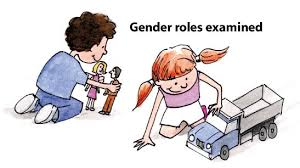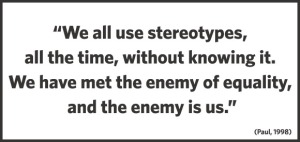Introduction
The purpose of this webpage is to shed light on two serious problems: sexism and gender bias, but specifically, the way the language and specific words we use every day that help to reinforce and perpetuate gender stereotypes. All words have meaning, otherwise we wouldn’t use them; we would just grunt and gesture at things to get our point across like modern day cave men and women. However, what most people don’t realize, is that it’s not always what we are trying to say that is the problem, it’s how we say it.
We as humans, a re pressured into behaving a certain way in regards to many social factors: where we were born, our socioeconomic background, race, religion, etc. But one of the most influential factors is our gender. From infancy, the way we are spoken to, dressed, or treated, by the people that surround us is determined by what genitalia we were born with. The majority of the time, we fit into the gender rolls assigned to us without much struggle. Girls wear the tiaras and play with the pretty toys,while boys build things and proceed to demolish them and play cops and robbers in the back yard with their toy pistols.
re pressured into behaving a certain way in regards to many social factors: where we were born, our socioeconomic background, race, religion, etc. But one of the most influential factors is our gender. From infancy, the way we are spoken to, dressed, or treated, by the people that surround us is determined by what genitalia we were born with. The majority of the time, we fit into the gender rolls assigned to us without much struggle. Girls wear the tiaras and play with the pretty toys,while boys build things and proceed to demolish them and play cops and robbers in the back yard with their toy pistols.
But what about the boy who would rather play with barbies and doll houses? Who feels better about himself when he is wearing his sisters princess dresses rather that his own tee shirts with monster trucks on them? Or the girl who spends all day outside with friends (most of whom are boys) wrestling and trying to prove herself worthy of being around? She doesn’t understand why she is inferior just because she is a girl. In many cases, these kind of behaviors are frowned upon; they tend to draw negative and often times violent attention from those who do not understand, or who cannot accept anything other that what is considered normal. It wasn’t till later on that she will start to pay attention to gender stereotypes, and begin to dress and behave in a way that was deemed appropriate. It is easy for her to cast aside the ponytail and ripped jeans. She is just as comfortable in leggings and curls, hanging out with her girlfriends. This way she is no longer the target of harassment. What is to be said for the little boy? Will he grow up and conform in order to be accepted by his piers? Or, will he hide that “feminine” part of himself from he public eyes but still hold on to the behaviors that came so naturally to him? Even if it could literally put him in physical harm?
The purpose of this webpage is to help that little boy and girl, and others like them. Giving them resources to help them understand that what they are feeling is totally normal. Information for that boy on how to cope with the rest of the world being against his choices, even find him a way to meet others like him. To help his parents gain the tools they need to relate to their son and make sure he knows he is accepted. And to help little girls understand why women are considered inferior and how to challenge this notion. This webpage was created to make a difference in the world we live in, and to change the ways in which we associate gender.
What are gender stereotypes?
Gender roles are sets of social norms dictating what types of behaviors are generally considered acceptable, appropriate or desirable for a person based on their actual or perceived gender. These are usually centered around opposing conceptions of femininity and masculinity, although there are a myriad of exceptions and variations. The specifics regarding these gender expectations may vary substantially among cultures, while other characteristics may be common throughout a range of cultures. There is ongoing debate as to what extent gender roles and their variations are biologically determined, and to what extent they are socially constructed.

Gender roles are cultural and personal. They determine how males and females should think, speak, dress, and interact within the context of society. Learning plays a role in this process of shaping gender roles. These gender schemas are deeply embedded cognitive frameworks regarding what society defines as masculine and feminine.
Gender bias in language, or sexist language, is language that stereotypes or demeans an individual or individuals because of their gender. Language that is sexist unnecessarily distinguishes between or brings attention to differences between men and women in ability, temperament, behavior, or occupation. Such language, whether used intentionally or unintentionally, often irritates or offends readers. Thus, writers should pay attention to their style to avoid gender bias.
This is really bad because people are swearing without knowing what it really means. Everyone should know what they are saying
Examples of gender stereotypes:
- Men are less emotional
- Men like blue and women like pink
- Women can’t play sports as good as men
- Men are messy and unclean
 Examples of changes in language that we as a community can do:
Examples of changes in language that we as a community can do:
- Mankind: people, human beings
- Fireman: firefighter
- Policeman and policewoman: police officer
Video Intro: A common word that gets thrown around almost everyday is the word “Bitch”. People may use the word toward other individuals, situations, or items. For example, “She/He is a bitch”, “That essay was a bitch”, or “Stop bitching”. “Bitch” is a word that is dismissive toward both male and female. In this video, you will get a better sense of what the word “bitch” really means and you can make a decision whether you wish to keep using it or not.
Where do gender stereotypes come from and who do they influence?
Kids at a young age are pretty much like sponges; they just absorb everything, so they say and do things without knowing what their actions or words actually mean. As I started looking at the more popular music videos and started listing to what musicians were saying in there lyrics I realized how stereotypical and demeaning they are to women. Kids ranging from ages 6-13 are being influenced by this new era of music, which is a lot more sexual and harsh language than before. If you actually listen to this music, you’d be extremely shocked how “rappers” today use gender-based language and just get away with it with nobody telling them anything. People accept their language and don’t even challenge it. For example, they call women “bitches”, “cunts”, “hoes” in the music, yet women still dance along to it at parties. With everybody accepting this language and the way the internet is set up,you can watch anything or listen to anything. Kids are affected because they hear this music and since everyone is so accepting of it, they don’t have any problem in using that same language. As kids see music videos and how musicians act, they try to fit those roles, weather it’s dancing the way they see people dancing in the videos, talking the way musicians do, or just trying to fit a gender roll. With kids that don’t fit into a gender roll are labeled as ‘not cool’ just for the simple fact that they don’t want to dance or act the way certain musicians do.

How can a person stop stereotyping?
In this quote, you can see that the real enemy to equality is ourselves. We as a community have become deaf to the stereotypical language that we may be using every single day, but why is this a problem? Using stereotypical language makes someone inferior to them. The words can be hurtful and most times untrue. Whether it be curse words or sexist language, people should get the opportunity to change their way of thinking by using substitute words. I believe a person can not completely stop stereotyping, but they sure can try. We as people can start encouraging others to learn and understand what the words that are coming out of their mouths actually mean.
Hotlines for help:
- Child Protective & Child Welfare Services Hotlines:
(707) 565-4304 (24-hour) or (800) 870-7064 -See more at: http://sonomacounty.ca.gov/Public-Safety/Hotlines-and-Emergencies/#sthash.Zznmc3d3.dpuf - North Bay Suicide Prevention Hotline: (855) 587-6373
- FTM (Female to male) Sonoma County, Colin Close, Director, 707-478-6177
- TGSF – San Francisco – Hotline: 415-564-3246
- Gay & Lesbian National Hotline
888-THE-GLNH
